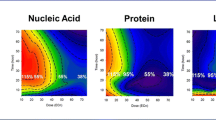Abstract
A number of silica-based nanomaterials have been developed in recent years. An important application of these nanomaterials is in the field of biological and biomedical applications. However, a major concern about the safety of the nanomaterials in vitro has been proposed. To address this problem, several approaches have been developed for a systematic investigation of the cytotoxicity and genotoxicity of silica-based nanoparticles. These methods are mainly based on the traditional toxicity study approaches but with some modifications. In this chapter, four important methods for studying of toxicity of silica-based nanomaterials are summarized. These methods can detect cell proliferation, cell viability, DNA damage, and the generation of reactive oxygen species (ROS). The protocols of each method are introduced in detail.
Access this chapter
Tax calculation will be finalised at checkout
Purchases are for personal use only
Similar content being viewed by others
References
Marquis BJ, Love SA, Braun KL, Haynes CL (2009) Analytical methods to assess nanoparticle toxicity. Analyst 134:425–439
Zhao X, Hilliard LR, Mechery JM, Wang Y, Jin S, Tan W (2004) A rapid bioassay for single bacterial cell quantization using bioconjugated nanoparticles. Proc Natl Acad Sci USA 101(42):15027–15032
Zhao X, Dytocio RT, Tan W (2003) Ultrasensitive DNA detection using highly fluorescent bioconjugated nanoparticles. J Am Chem Soc 125(38):11474–11475
Zhao X, Dytocio RT, Tan W (2003) Collection of trace amounts of DNA/mRNA molecules using genomagnetic nanocapturers. Anal Chem 75(14):3476–3483
Lin W, Huang YW, Zhou XD, Ma Y (2006) In vitro toxicity of silica nanoparticles in human lung cancer cells. Toxicol Appl Pharmacol 217:252–259
Liu X, Whitefield PD, Ma Y (2010) Quantification of F(2)-isoprostane isomers in cultured human lung epithelial cells after silica oxide and metal oxide nanoparticle treatment by liquid chromatography/tandem mass spectrometry. Talanta 81:1599–1606
Donaldson K, Stone V, Tran CL, Kreyling W, Borm PJA (2004) Nanotoxicology. Occup Environ Med 61:727–728
Jin Y, Li A, John CL, Hazelton SG, Liang S, Selid PD, Pierce DT, Zhao JX (2010) Amorphous silica nanohybrids: synthesis, properties and applications. Coord Chem Rev 253:2998–3014
Liang S, Hartvickson S, Kozliak E, Zhao JX (2009) Effect of amorphous silica nanomatrix on kinetics of metallation of encapsulated porphyrin molecules. J Phys Chem C 113:19046–19054
Xu S, Hartvickson S, Zhao JX (2008) Engineering of SiO2-Au-SiO2 sandwich nanoaggregates using a building block: single, double and triple cores for enhancement of near infrared fluorescence. Langmuir 24(14):7492–7499
Zhang Q, Matsuzaki I, Chatterjee S, Fisher AB (2005) Activation of endothelial NADPH oxidase during normoxic lung ischemia is KATP channel dependent. Am J Physiol Lung Cell Mol Physiol 289:954–961
Wan R, Mo Y, Zhang X, Chien S, Tollerud DJ, Zhang Q (2008) Matrix metalloproteinase-2 and -9 are induced differently by metal nanoparticles in human monocytes: the role of oxidative stress and protein tyrosine kinase activation. Toxicol Appl Pharmacol 233:276–285
Mossman T (1983) Rapid colorimetric assay for cellular growth and survival: application to proliferation and cytotoxicity assays. J Immunol Methods 65:55–63
Carmichael J, Degraff WG, Gazdar AF, Minna JD, Mitchell JB (1987) Evaluation of a tetrazolium-based semi-automated colorimetric assay: assessment of chemo sensitivity testing. Cancer Res 47:936–942
Sayes CM, Wahi R, Kurian PA, Liu Y, West JL, Ausman KD, Warheit DB, Colvin WL (2006) Correlating nanoscale titania structure with toxicity: a cytotoxicity and inflammatory response study with human dermal fibroblasts and human lung epithelial cells. Toxicol Sci 92:174–185
Hussain SM, Javorina AK, Schrand AM, Duhart HM, Ali SF, Schlager JJ (2006) The interaction of manganese nanoparticles with PC-12 cells induces dopamine depletion. Toxicol Sci 92:456–463
Jin Y, Kannan S, Wu M, Zhao JX (2007) Toxicity of luminescent silica nanoparticles to living cells. Chem Res Toxicol 20:1126–1133
Fröhlich E, Samberger C, Kueznik T, Absenger M, Roblegg E, Zimmer A, Pieber TR (2009) Cytotoxicity of nanoparticles independent from oxidative stress. J Toxicol Sci 34:363–375
Singh NP, McCoy MT, Tice RR, Schneider EL (1988) A simple technique for quantitation of low levels of DNA damage in individual cells. Exp Cell Res 175:184–191
Olive PL, Wlodek D, Durand RE, Banáth JP (1992) Factors influencing DNA migration from individual cells subjected to gel electrophoresis. Exp Cell Res 198:159–267
Czene S, Testa E, Nygren J, Belyaev I, Harms-Ringdahl M (2002) DNA fragmentation and morphological changes in apoptotic human lymphocytes. Biochem Biophys Res Commun 294:872–878
Al-Mehdi AB, Zhao G, Dodia C, Tozawa K, Costa K, Muzykanotv V, Ross C, Blecha F, Dinauer M, Fisher AB (1998) Endothelial NADPH oxidase as the source of oxidants in lungs exposed to ischemia or high K+. Circ Res 83:730–737
Acknowledgments
This work was supported by the National Science Foundation Grants CHE-0911472 and EPS-0814442.
Author information
Authors and Affiliations
Editor information
Editors and Affiliations
Rights and permissions
Copyright information
© 2013 Springer Science+Business Media New York
About this protocol
Cite this protocol
Zhao, Y., Jin, Y., Hanson, A., Wu, M., Zhao, J.X. (2013). Methods for Studying Toxicity of Silica-Based Nanomaterials to Living Cells. In: Rosenthal, S., Wright, D. (eds) NanoBiotechnology Protocols. Methods in Molecular Biology, vol 1026. Humana Press, Totowa, NJ. https://doi.org/10.1007/978-1-62703-468-5_15
Download citation
DOI: https://doi.org/10.1007/978-1-62703-468-5_15
Published:
Publisher Name: Humana Press, Totowa, NJ
Print ISBN: 978-1-62703-467-8
Online ISBN: 978-1-62703-468-5
eBook Packages: Springer Protocols




